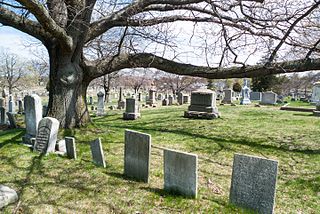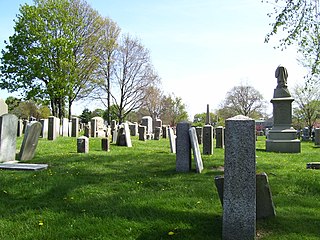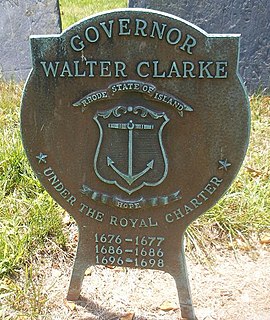
The Granary Burying Ground in Massachusetts is the city of Boston's third-oldest cemetery, founded in 1660 and located on Tremont Street. It is the final resting place for many notable Revolutionary War-era patriots, including Paul Revere, the five victims of the Boston Massacre, and three signers of the Declaration of Independence: Samuel Adams, John Hancock, and Robert Treat Paine. The cemetery has 2,345 grave-markers, but historians estimate that as many as 5,000 people are buried in it. The cemetery is adjacent to Park Street Church, behind the Boston Athenaeum and immediately across from Suffolk University Law School. It is a site on Boston's Freedom Trail.

The North Burial Ground is a 110-acre (0.45 km2) cemetery in Providence, Rhode Island dating to 1700, the first public cemetery in Providence. It is located north of downtown Providence, bounded by North Main Street, Branch Avenue, the Moshassuck River, and Cemetery Street. Its main entrance is at the junction of Branch and North Main. The burial ground is one of the larger municipal cemeteries in Southern New England, and it accepts 220 to 225 burials per year.
Nicholas Easton (c.1593–1675) was an early colonial President and Governor of Rhode Island. Born in Hampshire, England, he lived in the towns of Lymington and Romsey before immigrating to New England with his two sons in 1634. Once in the New World, he lived in the Massachusetts Bay Colony towns of Ipswich, Newbury, and Hampton. Easton supported the dissident ministers John Wheelwright and Anne Hutchinson during the Antinomian Controversy, and was disarmed in 1637, and then banished from the Massachusetts colony the following year. Along with many other Hutchinson supporters, he settled in Portsmouth on Aquidneck Island, later a part of the Colony of Rhode Island and Providence Plantations. He was in Portsmouth for about a year when he and eight others signed an agreement to create a plantation elsewhere on the island, establishing the town of Newport.

Touro Synagogue Cemetery, dedicated in 1677, is located in the colonial historic district of Newport, Rhode Island, not far from the Touro Synagogue. Other Jewish graves are found nearby as part of the Common Burying Ground and Island Cemetery on Farewell Street.
John Cranston (1625–1680) was a colonial physician, military leader, legislator, deputy governor and governor of the Colony of Rhode Island and Providence Plantations during the 17th century.

Joseph Wanton Sr. was a merchant and governor of the Colony of Rhode Island and Providence Plantations from 1769 to 1775. Not wanting to go to war with Britain, he has been branded as a Loyalist, but he remained neutral during the war, and he and his property were not disturbed.

Joseph Wanton Jr. (1730–1780) was a Loyalist, merchant, Deputy Governor of Rhode Island in 1764 and 1767 and owner of Hunter House in Newport, Rhode Island.

The Common Burying Ground and Island Cemetery are a pair of separate cemeteries on Farewell and Warner Street in Newport, Rhode Island. Together they contain over 5,000 graves, including a colonial-era slave cemetery and Jewish graves. The pair of cemeteries was added to the National Register of Historic Places as a single listing in 1974.

Jeremy Clarke (1605–1652) was an early colonial settler and President of the Colony of Rhode Island and Providence Plantations. Born into a prominent family in England, he was a merchant who came to New England with his wife, Frances Latham, and four stepchildren, settling first at Portsmouth in 1638, but the following year joining William Coddington and others in establishing the town of Newport. Here he held a variety of civic positions until 1648 when Coddington's election as President of the colony was disputed, and Clarke was chosen to serve in that office instead. He was the father of Walter Clarke, another colonial governor of Rhode Island, and also had family connections with several other future governors of the colony.

Walter Clarke (1640–1714) was an early governor of the Colony of Rhode Island and Providence Plantations and the first native-born governor of the colony. The son of colonial President Jeremy Clarke, he was a Quaker like his father. His mother was Frances (Latham) Clarke, who is often called "the Mother of Governors." While in his late 20s, he was elected as a deputy from Newport, and in 1673 was elected to his first of three consecutive terms as assistant. During King Philip's War, he was elected to his first term as governor of the colony. He served for one year in this role, dealing with the devastation of the war, and with the predatory demands of neighboring colonies on Rhode Island territory during the aftermath of the war.
Henry Bull (1610–1694) was an early colonial Governor of Rhode Island, serving for two separate terms, one before and one after the tenure of Edmund Andros under the Dominion of New England. Sailing from England as a young man, Bull first settled in Roxbury in the Massachusetts Bay Colony, but soon became a follower of the dissident ministers John Wheelwright and Anne Hutchinson, and was excommunicated from the Roxbury church. With many other followers of Hutchinson, he signed the Portsmouth Compact, and settled on Aquidneck Island in the Narragansett Bay. Within a year of arriving there, he and others followed William Coddington to the south end of the island where they established the town of Newport.

Arnold Burying Ground is a historic cemetery on Pelham Street just east of Spring Street in Newport, Rhode Island. It is the burial place of Benedict Arnold, Rhode Island's first governor under the Royal Charter of 1663.

Caleb Carr was a governor of the Colony of Rhode Island and Providence Plantations, serving a very short term prior to his death. In 1635, at the age of 11, he sailed from England on the ship Elizabeth and Ann with his older brother Robert. Carr's name appears on a list of Newport freemen in 1655, and he began serving in a civil capacity the year prior when he became a commissioner. He served in this capacity for a total of six years between 1654 and 1662, and then served as deputy for 12 years from 1664 to 1690. During the years when he wasn't serving as deputy, he was an assistant, serving in this role for a total of ten years. From 1677 to 1678 he was the justice of the General Quarter Session and Inferior Court of Common Pleas.

William Wanton was a governor of the Colony of Rhode Island and Providence Plantations, serving a short term prior to his death. He spent most of his adult life in the civil and military service of the colony and commanded a sloop for chasing privateers.

John Wanton was a governor of the Colony of Rhode Island and Providence Plantations, serving for six consecutive terms from 1734 to 1740. He was the son of Edward Wanton who was a ship builder, and who became a Quaker after witnessing the persecution of these people, also becoming a preacher of that religion. Edward Wanton had lived in York, Maine; Boston, Massachusetts; and Scituate, Massachusetts before coming to Rhode Island.

Gideon Wanton was a governor of the Colony of Rhode Island and Providence Plantations who served for two separate one-year terms. His father was Joseph Wanton, a shipbuilder in Tiverton, and his mother was Sarah Freeborn, the daughter of Gideon and Sarah (Brownell) Freeborn. One of his great grandfathers was William Freeborn, who signed the Portsmouth Compact, becoming a founder of Portsmouth in the Rhode Island colony. Both of Wanton's parents were Quakers, and both were public speakers within the denomination.
Henry Tew was a deputy governor of the Colony of Rhode Island and Providence Plantations. He was the son of Richard and Mary (Clarke) Tew who arrived in New England in 1640, and the grandson of Henry Tew of Maidford, Northamptonshire, England. From 1680 to 1698 he served continuously as Deputy from Newport, and during most of the years from 1703 to 1712 he served as Assistant. He was on many committees during his life, one of the later ones being to advise Governor Cranston on matters concerning the expedition against Canada. In 1714 he succeeded the late Walter Clarke as Deputy Governor, serving for a single year. Tew wrote his will on 20 April 1718, dying six days later. He was married twice, having nine children by his first wife, and nine by his second. He and both wives are buried in a family burial ground half a mile north of Sachuest Beach, in Middletown, Rhode Island. There is some evidence that Tew was the brother of the privateer and pirate, Thomas Tew.

The Coddington Cemetery is an early colonial cemetery located in Newport, Rhode Island, USA. It is sometimes called the Friends' Burial Ground, and has more colonial governors buried in it than any other cemetery in the state.
Frances Latham, was a colonial American woman who settled in Rhode Island, and is known as "the Mother of Governors." Having been widowed twice, she had three husbands, and became the ancestor of at least ten governors and three deputy/lieutenant governors, and is related by marriage to an additional six governors and one deputy governor.

The Governor Greene Cemetery, frequently called the Governor Greene Lot, is designated as Rhode Island Historical Cemetery, Warwick, #40, and is a late colonial cemetery located in Warwick, Rhode Island near the East Greenwich town line. It is a family cemetery with the graves of two Rhode Island governors, and other prominent politicians who are related to them.




















